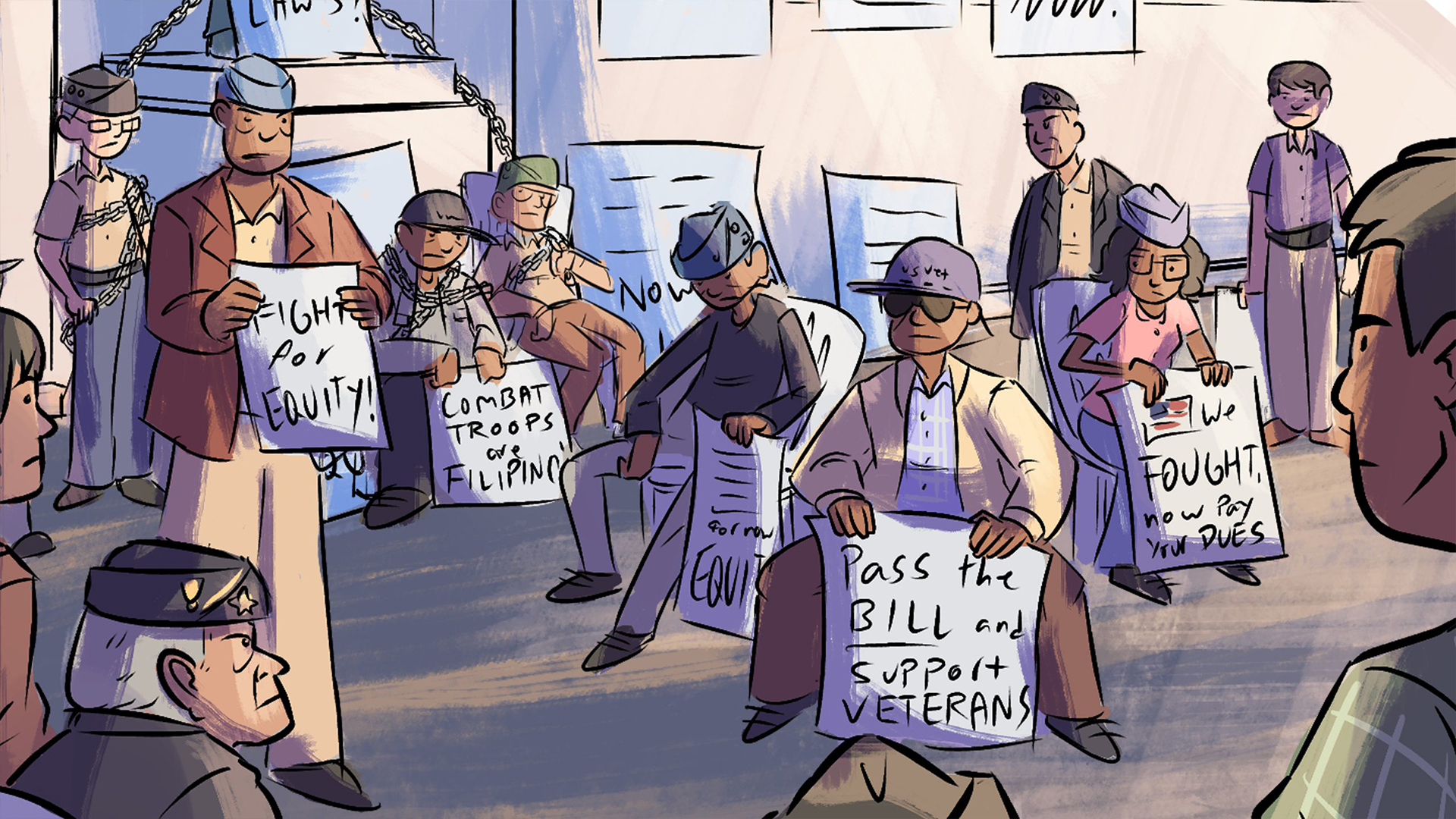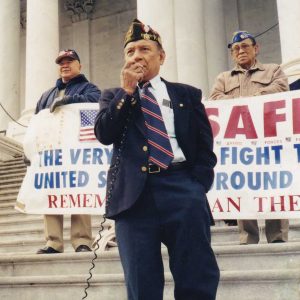Lesson Plan 10:

You Decide: Filipino Veterans’ Long Fight for Justice (Modified)
This is a shorter version of “You Decide,” adapted for middle school and/or lower-level readers; students read scenarios and debate what to do at three key turning points in the veterans movement to gain benefits.
Summary
In this lesson, students debate what to do at each of three key turning points in the long fight for veterans’ benefits and recognition. They learn about the different strategies activists employed, discover how they responded to setbacks, and consider how citizens can hold their government accountable.
This lesson is a modified version of Lesson 5; it includes fewer scenarios and shorter, less complex texts than the full version. The instructions include suggested modifications for ELL or other lower-level readers.
Time
40 minutes (some modifications for lower-level readers may take additional time)
Materials
- Greatest Generation illustration: https://exhibition.dutytocountry.org/illustration-gallery/illus-170-greatest-generation/
- Scenario handouts (each student should have a copy of each scenario).
Grade Level/Subject
High School or Middle School Social Studies
Common Core: Middle School
- CCSS.ELA-LITERACY.RH.6-8.1 Cite specific textual evidence to support analysis of primary and secondary sources.
- CCSS.ELA-LITERACY.RH.6-8.2 Determine the central ideas or information of a primary or secondary source; provide an accurate summary of the source distinct from prior knowledge or opinions.
UCLA Public History Initiative | US History Content Standards
- Era 9, Standard 4: The struggle for racial and gender equality and the extension of civil liberties
- Era 10, Standard 1: Recent developments in foreign and domestic policies
Instructions
1. Introduction (5 minutes): Greatest Generation
Display the “Greatest Generation” illustration from the exhibit Under One Flag. Ask students to describe what’s going on in the illustration: who’s taking action, where are events happening, and what are the people asking for? Students should identify that these are scenes of activists in the long struggle for Filipino veterans benefits. In today’s lesson, students will learn the real story behind these scenes.
2. Role Play (at least 30 minutes; allow extra time to diagram texts as needed):
Break students into groups of 3-4. Pass out the first scenario about The Rescission Act. Allow students time to read the scenario, then to debate the options on the card (5-7 minutes each). Students must decide what to do, whether by selecting one of the options presented or designing their own response. Ask each group to share out what choice they made and why. Then reveal what actually happened before introducing the next scenario. Repeat until all scenarios have been debated.
- 1946: The Rescission Act | What Really Happens: The Philippines reject the offer; diplomat Carlos P. Romulo, himself a veteran, testifies before the U.S. Congress in 1948, saying: “The Rescission Act deprives Filipino veterans of veterans’ benefits, with the proviso that $200 million be appropriated to the Army of the Philippines. These $200 million, which are purportedly in lieu of the benefits of which Filipino veterans were thus deprived, are actually not even sufficient to cover their back pay. The Philippine Government has chosen not to accept the appropriation.”
- 1980s: Change the Law | What Really Happens: Filipino veterans and their advocates tried all of these strategies, often at the same time. Senator Daniel Inouye introduced a bill every year for 18 years to repeal the Rescission Act. DC-based veterans were a regular sight in the halls of Congress. Activists like Jon Melegrito started working with college students at George Washington University to teach them the history and get them engaged in the fight. Nearly every Filipino American community organization was involved in some way. But Congress only met the activists half way: the Immigration Act of 1990 included a provision that allowed for the naturalization of Filipino veterans without providing for benefits or overturning the Rescission Act.
- 1990s: Getting Confrontational | What Really Happens: The fight enters its most confrontational phase, with veterans and their allies participating in all kinds of civil disobedience. Several powerful new groups are formed, They stage a “Bataan Death March” in Washington, D.C. They do sit-ins in V.A. offices. Protestors set up an encampment in L.A.’s MacArthur Park and chain themselves to the gates of the White House in Washington, D.C. After attending a hearing of the Veterans’ Affairs Committee, during which their benefits are again denied, they break out into a spontaneous chorus of “God Bless America.” They win limited health and burial benefits, but that’s about it until 2009. Then, Senator Inouye manages to insert a Filipino Veterans Equity Compensation Fund (FVEC) into the 2009 stimulus bill passed by President Barack Obama. Soon afterward, Congress allocated $198 million to the fund and awarded payments of $15,000 for eligible Filipino veterans who were U.S. citizens. It provided $9,000 for Filipino veterans who were Philippine citizens. About 48,000 veterans navigated the complicated process to obtain these benefits before time expired. The law also recognized that service in USAFFE was, indeed service “in” the U.S. armed forces. In 2016, advocates also obtained a Congressional Gold Medal, the nation’s highest civilian honor, in recognition of Filipino veterans’ service. To this day, the Rescission Act has never been repealed.
The scenario cards are written at 6th and 7th grade reading levels. There are many ways to adapt this section of the lesson, including by reading the texts aloud as a group or having students work independently. These strategies may help students diagram and make sense of the texts:
- Have students create a timeline of dates in the scenarios in order to keep track of where in time the scenario takes place (1946, late 1980s, late 1990s). For dates after 1946, they can note what has changed since the previous scenario, and what is still the same.
- Before starting the scenarios, have students make a checklist of veterans’ demands. It should include the following: full benefits (pensions, healthcare, etc.), immigration rights, stipends (small payments that are not full benefits), recognition/respect, an apology, repeal of the Rescission Act. Students can cross off what things are accomplished as they go through the activity.
For advanced readers, use Scenarios 1, 3 and 5 in Lesson 5. These are longer texts with more details, but convey roughly the same information. These texts, written at a 9th grade reading level, allow you to differentiate in a mixed-ability classroom.
3. Conclusion (5 minutes)
Ask students to reflect on the long activist movement for justice and equity for Filipino veterans; a few questions for discussion are below:
- What were some of the actions that activists used to try to gain benefits and recognition?
- Are you surprised that it took so long to get any sort of change or recognition? Why or why not?
- Why do you think it was so difficult to obtain benefits for Filipino veterans?
- What have you learned about activism and the role of citizens in making change in a democracy?
- Would you say that justice has been achieved? If not, what, if anything, can be done at this point to honor Filipino veterans and hold the U.S. to its promises and ideals?
Related Explainers
Scenario Handouts
Scenario 1: The Rescission Act
It’s 1946. World War II is over. Throughout the war, Filipinos fought bravely. Many fighters were guerrillas. Guerrillas did everything they could to defeat the Japanese even if they did not have good weapons or training. More than 200,000 Filipinos, including guerrillas, served in the United States Armed Forces during World War II. They risked everything to free their homeland. Hundreds of thousands of Filipinos were killed during the war, including at least 57,000 fighters.
At the end of the war, Americans keep their promise to grant independence to the Philippines. In Manila, officials hold a solemn ceremony. The American flag comes down. The flag of the new Philippine Republic goes up.
The United States and the Philippines still have strong ties. The U.S. sets up 23 military bases in the Philippines. The U.S. trains, provides equipment, and gives money to the Philippines military. The U.S. negotiates new trade laws with the Philippines that favor American business interests and keep the two countries tied together economically.
Filipinos also have family ties to the United States. Many people in the Philippines have family members who immigrated to the United States when the Philippines were a U.S. colony. Now that the war is over, many Filipinos would like to immigrate to the United States and join their family members. However, racist U.S. immigration laws restrict how many Filipinos can come to the U.S. Only 100 visas are granted to Filipinos every year.
During the war, Filipinos and Americans fought under one flag. After the war, these fighters should have access to veterans benefits. Benefits include pensions and healthcare. In America, the U.S. government is paying billions of dollars to provide benefits to veterans.
Filipinos should also have the right to become U.S. citizens and move to the United States.
But Americans aren’t honoring their promises. Immigration offices in the Philippines are closed. The U.S. Congress passes a law called the Rescission Act. They say it’s to save money. One part of the law says that Filipinos who served in the war aren’t considered veterans of the U.S. Armed Forces. That means Filipino veterans can’t get the benefits that other World War II veterans have.
To help the new Philippines government pay for veterans benefits, the United States offers a one-time payment of $200 million. The U.S. says, going forward, veterans are the Philippines’ problem, not the United States’ problem.
Solemn: Serious.
Visa: A passport or other documentation stating that the person is allowed to enter, leave, or stay for a specified period of time in a country.
Pension: A regular payment made during a person’s retirement.
Rescission Act: A law passed by Congress in 1946 that cut spending and cut off Filipino veterans’ benefits.
Imagine you’re a Philippine diplomat in 1946. You have to decide whether to take the $200,000,000 from the Americans.
What do you do?
A. Accept the offer. $200,000,000 may not be enough, but it’s better than nothing. Your country is poor and can use the money to build hospitals and help take care of veterans. Besides, it’s important to stay on good terms with your biggest ally.
B. Reject the offer. After all the sacrifices of the war, this offer is insulting. America made a promise to Filipinos and Filipino veterans are owed those benefits. Besides, if we accept this money now, it may be harder to ask for more in the future.
C. Something else. (In your group, come up with another solution.)
Diplomat: An official representing a country abroad.
Ally: a nation that formally agrees to support your country
Scenario 2: Change the Law
America has broken its promise. Because of the Rescission Act, veterans can’t get benefits like pensions and healthcare. They cannot immigrate to the United States and reunite with their families.
Veterans protest. Filipino diplomats complain. They reject the offer of $200 million. But nothing changes. A new immigration law in 1965 allows many Filipinos to come to the United States, but the government does not change its mind about benefits.
Now it’s the 1980s. Veterans are getting old. Their children and grandchildren join the fight. The younger generation has fresh energy. They are inspired by the civil rights movement. Young Filipino Americans work with other Asian Americans from different backgrounds (Chinese, Korean, Japanese, Vietnamese) to push for equal rights for all Asian Americans.
In 1988, Congress passes a law to apologize for Japanese internment during World War II. It also provides $20,000 payments to each survivor. The law gives hope to Filipino activists. Maybe Congress will do something for them too.
It took almost 10 years for Congress to pass a bill for Japanese internment survivors. Filipino veterans are aging. It has been forty years. Can they wait another ten years?
To win, Filipino veterans will have to educate Congress. Congress people need to understand the Rescission Act. They need to understand how it affects benefits and immigration.
Activists debate what will get the quickest result. There are many ways to try to make change.
Diplomat: An official representing a country abroad.
Japanese internment: During World War II, the U.S. forced Japanese American citizens to leave their homes and live in internment camps. This action was motivated by fear and racism towards the Japanese
You’re an activist in the late 1980s.
How do you get Congress to act?
A. Get a Congressional advocate to introduce a bill to repeal the Rescission Act. The U.S. needs to admit it made a mistake. Once the law is repealed, Filipino veterans can claim their benefits.
B. Focus on changing immigration laws so that more Filipino veterans can immigrate to the U.S. if they desire. This will help reunite families. Also, unlike benefits, immigration doesn’t cost the government anything.
C. Focus on educating members of Congress. Help them understand the Rescission Act. Visit members of Congress and force them to look veterans in the face and hear their stories. If members don’t understand the history, they won’t vote for a bill, especially if it costs money.
D. Rally grassroots supporters to call Congress. Without pressure from the outside, Congress won’t feel any urgency about the issue. Remind Congress that the Filipino American community is paying attention and its numbers are growing. Get major veterans groups, like the American Legion and the Veterans of Foreign Wars, to take up the cause of Filipino veterans.
E. Practice acts of nonviolent civil disobedience. Organize sit-ins and marches in Washington, D.C., California, and other places. Elderly veterans can lead the way, with the back-up of college students and other activists. Get attention. Make things uncomfortable for those who ignore Filipino veterans.
F. Something else. (In your group, come up with another solution.)
Advocate: A member of Congress who agrees to be your champion on the issue you care about.
Repeal: Undo or annul an earlier law.
Rally: Organize and inspire.
Grassroots: Everyday, ordinary people.
Civil disobedience: A form of peaceful protest by which the protestor refuses to follow an unjust law.
Scenario 3: Getting Confrontational
After years of asking Congress, Filipino veterans have a break-through. Congress passes the Immigration Act of 1990, It allows more Filipino veterans to apply for U.S. citizenship. It’s not everything that activists have asked for, but it’s a start. About 25,000 veterans apply.
But the Rescission Act is still the law. Congress refuses to spend money to pay for benefits for Filipino veterans. Congress members say the law means that they are not obligated to care for Filipino veterans.
College students get more engaged in the fight. Many are the grandchildren of veterans. They were raised in the United States. They never lived under colonial rule. They say the United States treats Filipinos like “little brown brothers” and does not respect them. Some young activists are willing to be more aggressive, even if it means getting arrested. They are inspired by elderly veterans who protest in wheelchairs and on crutches.
It’s the 1990s now. It’s been more than 50 years since the Rescission Act and the end of World War II. More Congress people are now on their side. But it’s still not enough to pass a law to give benefits, or to repeal the Rescission Act.
There is one opponent in Congress who won’t change his mind. His name is Representative Bob Stump. He has a lot of power to decide whether bills for Filipino veterans benefits can move forward. To get something done, activists will have to convince Representative Stump.
Aggressive: Ready to be confrontational.
Opponent: Someone who disagrees with your point of view.
You’re an activist in 1997. A new Congressional term has just started. Veterans are aging and dying off. It’s starting to feel like now or never.
What do you do?
A. Accept that there isn’t enough Congressional support for spending money on benefits for Filipino veterans. After more than 50 years, now that veterans are dying off, turn your attention to educating the general public about their service.
B. Push to repeal the Rescission Act. As long as it remains on the book, it’s a stain on America and will prevent further Congressional action on behalf of Filipino veterans.
C. Ask for a formal apology, but let the benefits issue drop. Citizenship for those veterans who want it and recognition that the U.S. was wrong are still major accomplishments.
D. Organize marches and sit-ins in and in front of government buildings. Stage protests in high-profile places like Congress, V.A. offices and public parks. Do this while continuing to educate Congress members about the history of Filipino veterans and the Rescission Act.
E. Chain yourself to the gates of the White House and start a hunger strike. It may anger some people, but the stakes are high and it’s time to take things to the next level.
F. Show up to public meetings, including those with V.A. officials and hearings of the Veterans Affairs Committee, to ask disruptive questions and demand benefits. Confront Representative Stump and others in the halls of Congress, even if it includes shouting or other impolite behavior.
G. Something else. (In your group, come up with another solution.)


